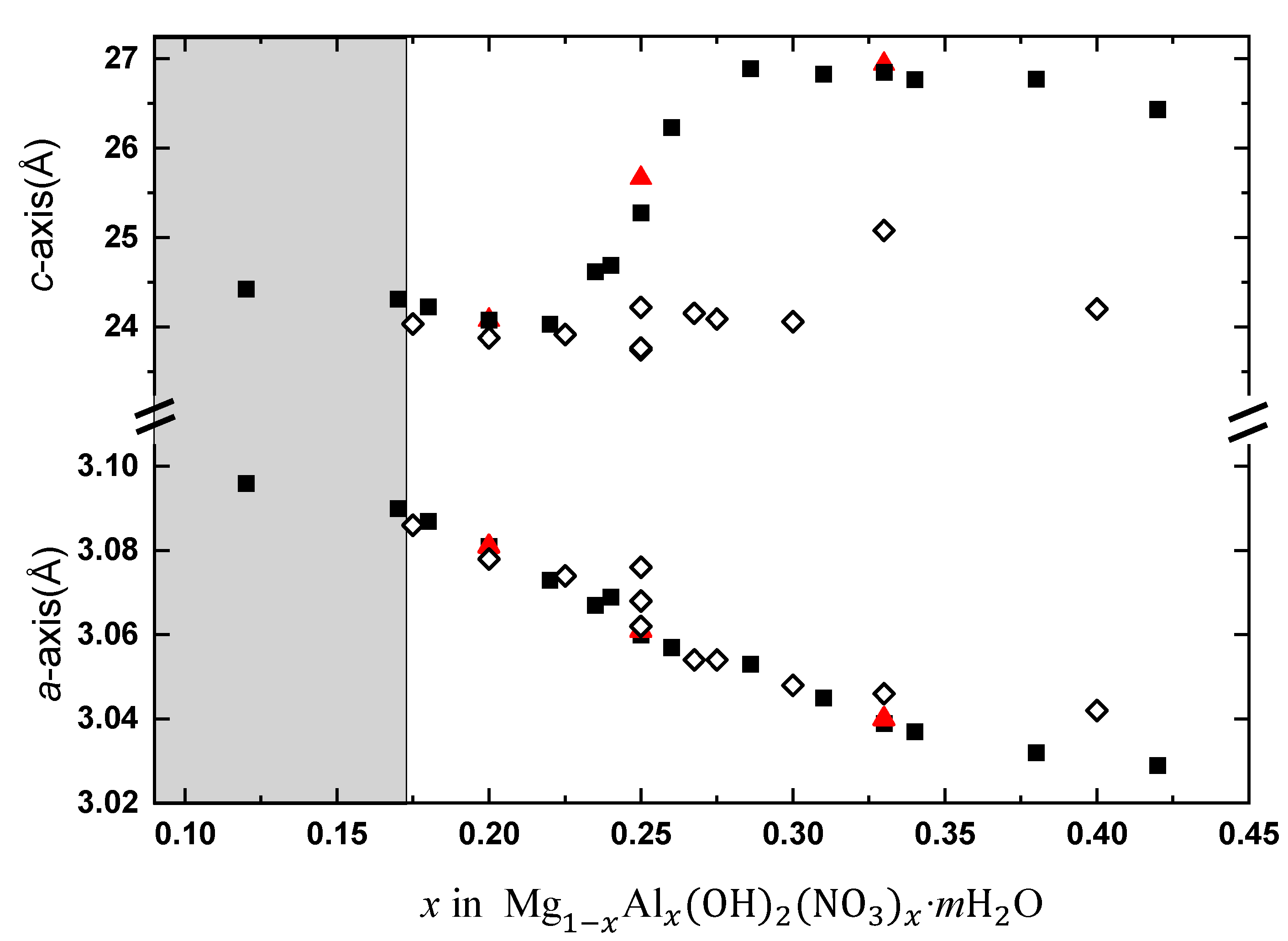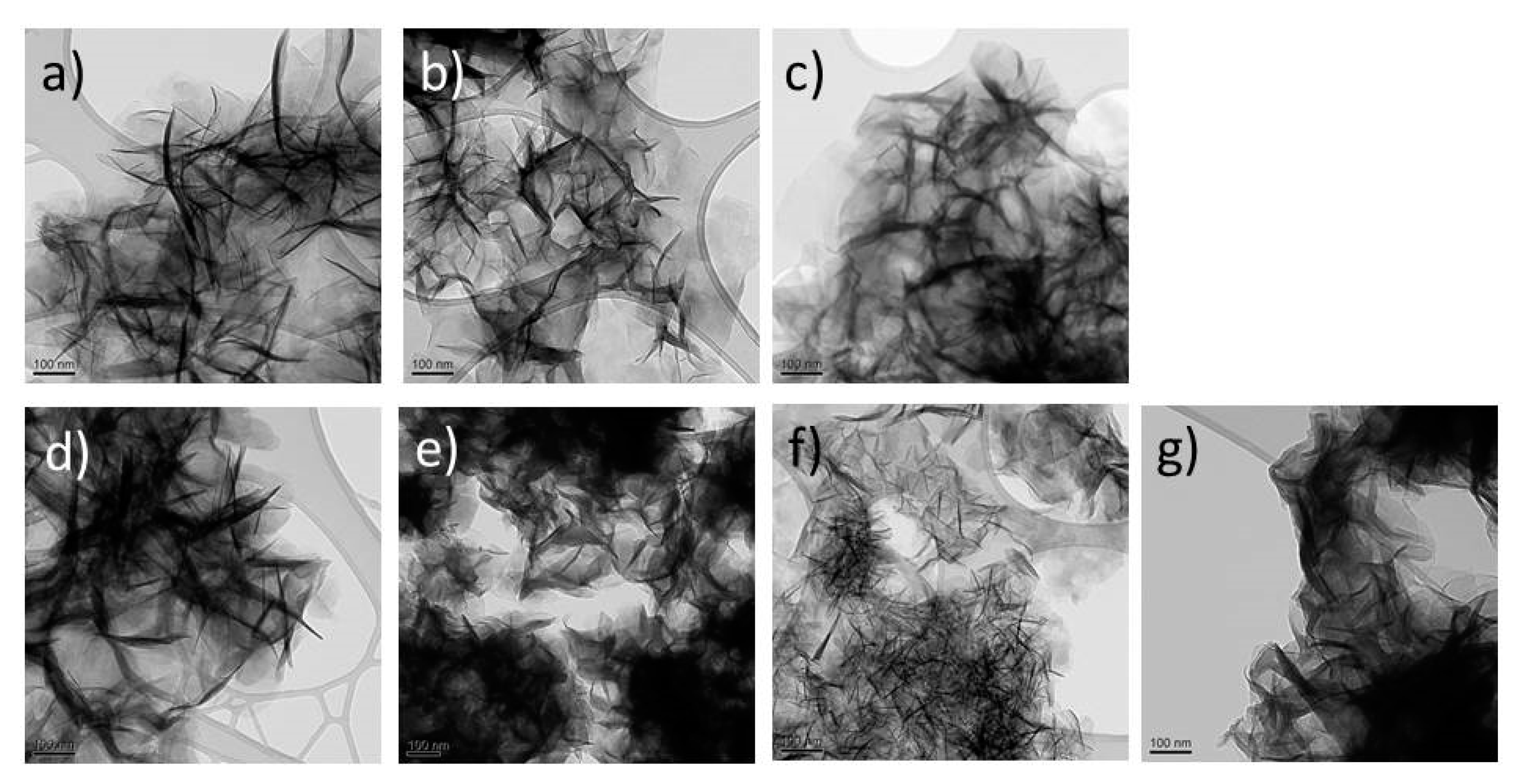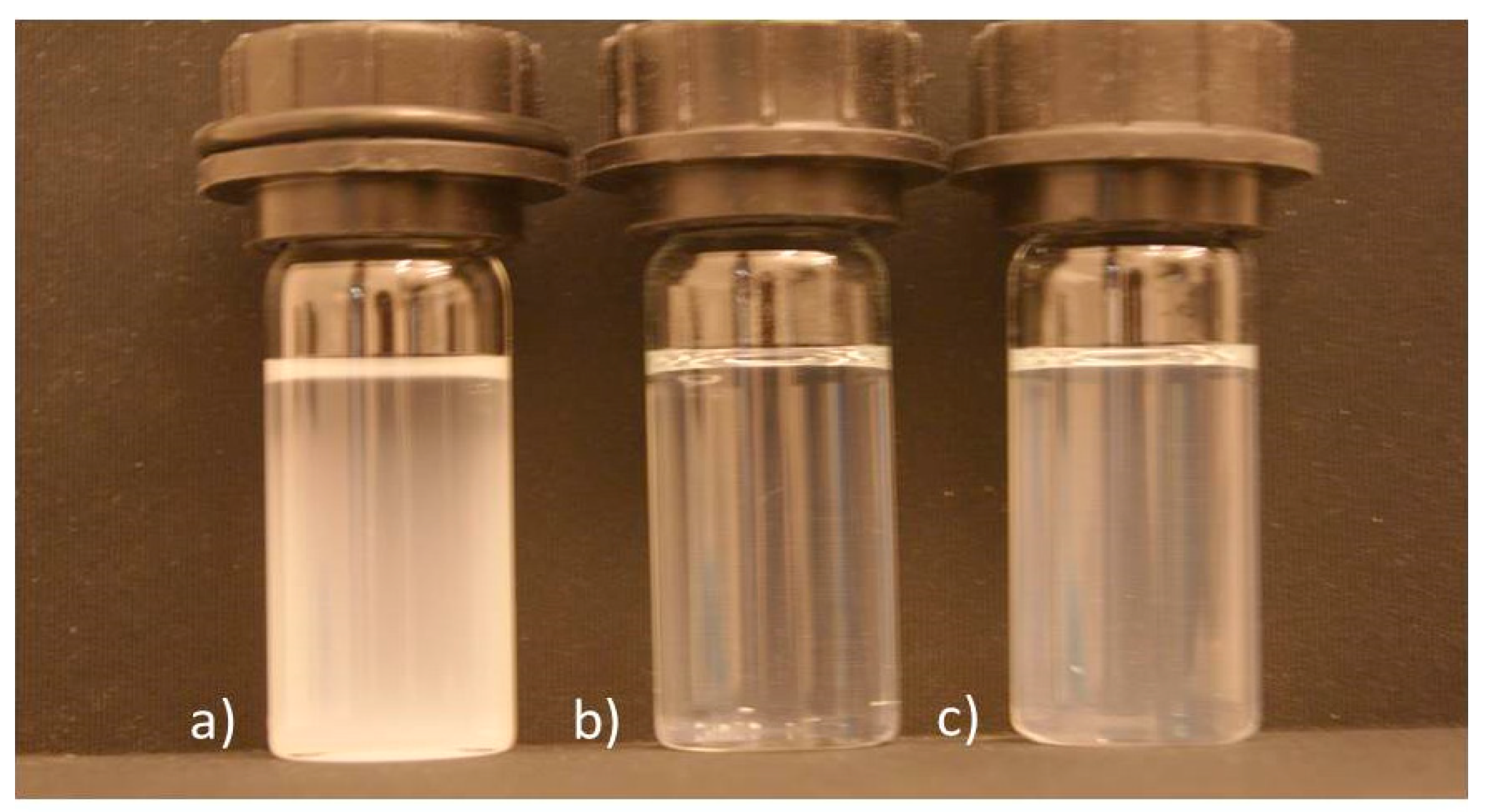Efficient Exfoliation of Layered Double Hydroxides; Effect of Cationic Ratio, Hydration State, Anions and Their Orientations
Abstract
:1. Introduction
2. Materials and Methods
2.1. Synthesis and Characterization
2.2. Pre-Treatment, Exfoliation, Quantification and Characterization
3. Results
3.1. Materials; Hydration, Morphology and Effect of Anions
3.2. Exfoliation, Quantification, and Characterization of Suspensions
4. Discussion
5. Conclusions
Supplementary Materials
Author Contributions
Funding
Data Availability Statement
Acknowledgments
Conflicts of Interest
References
- Dragoman, M.; Dragoman, D. Nanoelectronics: Principles and Devices; Artech House: Boston, MA, USA, 2006; ISBN 1580536948/9781580536943. [Google Scholar]
- Shi, J.; Zhu, Y.; Zhang, X.; Baeyens, W.R.; García-Campaña, A.M. Recent developments in nanomaterial optical sensors. TrAC Trends Anal. Chem. 2004, 23, 351–360. [Google Scholar] [CrossRef]
- Himpsel, F.; Ortega, J.; Mankey, G.; Willis, R. Magnetic Nanostructures. Adv. Phys. 1998, 47, 511–597. [Google Scholar] [CrossRef]
- Zhao, J.; Stearns, L.C.; Harmer, M.P.; Chan, H.M.; Miller, G.A.; Cook, R.F. Mechanical Behavior of Alumina–Silicon Carbide Nanocomposites. J. Am. Ceram. Soc. 1993, 76, 503–510. [Google Scholar] [CrossRef]
- Duan, X.; Evans, D.G. Layered Double Hydroxides; Springer: Berlin/Heidelberg, Germany; New York, NY, USA, 2006; Volume 119, ISBN 978-3-540-28279-2. [Google Scholar]
- Iyi, N.; Matsumoto, T.; Kaneko, Y.; Kitamura, K. Deintercalation of carbonate ions from a hydrotalcite-like compound: Enhanced decarbonation using acid-salt mixed solution. Chem. Mater. 2004, 16, 2926–2932. [Google Scholar] [CrossRef]
- Ma, R.; Sasaki, T. Nanosheets of Oxides and Hydroxides: Ultimate 2D Charge-Bearing Functional Crystallites. Adv. Mater. 2010, 22, 5082–5104. [Google Scholar] [CrossRef]
- Johnsen, R.E.; Wu, Q.; Sjåstad, A.O.; Vistad, Ø.B.; Krumeich, F.; Norby, P. Nanostructured materials produced by mixing and restacking of delaminated layered double hydroxides. J. Phys. Chem. C 2008, 112, 16733–16739. [Google Scholar] [CrossRef]
- Karthikeyan, J.; Song, H.; Olsbye, O.; Fjellvåg, H.; Sjåstad, A.O. Supported Nickel Based Catalysts, Ni/Mg(Al)O, for Natural Gas Conversion, Prepared via Delamination and Restacking of MgAl- and NiAl-Nanosheets. Top. Catal. 2015, 58, 877–886. [Google Scholar] [CrossRef]
- Takahashi, N.; Hata, H.; Kuroda, K. Exfoliation of layered silicates through immobilization of imidazolium groups. Chem. Mater. 2011, 23, 266–273. [Google Scholar] [CrossRef]
- Hibino, T.; Jones, W. New approach to the delamination of layered double hydroxides. J. Mater. Chem. 2001, 11, 1321–1323. [Google Scholar] [CrossRef]
- Karthikeyan, J.; Fjellvåg, H.; Knudsen, K.; Vistad, Ø.B.; Sjåstad, A.O. Quantification and key factors in delamination of (Mg1−yNiy)1−xAlx(OH)2(NO3)x·mH2O. Appl. Clay Sci. 2016, 124–125, 102–110. [Google Scholar] [CrossRef]
- Li, L.; Ma, R.; Ebina, Y.; Iyi, N.; Sasaki, T. Positively charged nanosheets derived via total delamination of layered double hydroxides. Chem. Mater. 2005, 17, 4386–4391. [Google Scholar] [CrossRef]
- Wu, Q.; Olafsen, A.; Vistad, Ø.B.; Roots, J.; Norby, P. Delamination and restacking of a layered double hydroxide with nitrate as counter anion. J. Mater. Chem. 2005, 15, 4695–4700. [Google Scholar] [CrossRef]
- Adachi-Pagano, M.; Forano, C.; Besse, J.-P. Delamination of layered double hydroxides by use of surfactants. Chem. Commun. 2000, 91–92. [Google Scholar] [CrossRef]
- Hibino, T. Delamination of layered double hydroxides containing amino acids. Chem. Mater. 2004, 16, 5482–5488. [Google Scholar] [CrossRef]
- Radha, A.V.; Shivakumara, C.; Vishnu Kamath, P. DIFFaX simulations of stacking faults in layered double hydroxides (LDHs). Clays Clay Miner. 2005, 53, 520–527. [Google Scholar] [CrossRef]
- Wang, S.L.; Wang, P.C. In situ XRD and ATR-FTIR study on the molecular orientation of interlayer nitrate in Mg/Al-layered double hydroxides in water. Colloids Surf. A Physicochem. Eng. Asp. 2007, 292, 131–138. [Google Scholar] [CrossRef]
- Sjåstad, A.O.; Andersen, N.H.; Vajeeston, P.; Karthikeyan, J.; Arstad, B.; Karlsson, A.; Fjellvåg, H. On the Thermal Stability and Structures of Layered Double Hydroxides Mg1–xAlx(OH)2(NO3)x·mH2O(0.18 < x < 0.38). Eur. J. Inorg. Chem. 2015, 2015, 1775–1788. [Google Scholar] [CrossRef]
- Shivanna, M.; Radha, S.; Kamath, P.V. Nitrate-Intercalated Layered Double Hydroxides –Structure Model, Order, and Disorder. Eur. J. Inorg. Chem 2013, 2122–2128. [Google Scholar] [CrossRef]
- Wu, Q.; Sjåstad, A.O.; Vistad, Ø.B.; Knudsen, K.D.; Roots, J.; Pedersen, J.S.; Norby, P. Characterization of exfoliated layered double hydroxide (LDH, Mg/Al = 3) nanosheets at high concentrations in formamide. J. Mater. Chem. 2007, 17, 965–971. [Google Scholar] [CrossRef]
- Meng, C.; Zhu, R.; Lu, X.; Zhu, J.; He, H. Influences of Cation Ratio, Anion Type, and Water Content on Polytypism of Layered Double Hydroxides. Inorg. Chem. 2018, 57, 7299–7313. [Google Scholar] [CrossRef]
- Iyi, N.; Fujii, K.; Okamoto, K.; Sasaki, T. Factors influencing the hydration of layered double hydroxides (LDHs) and the appearance of an intermediate second staging phase. Appl. Clay Sci. 2007, 35, 218–227. [Google Scholar] [CrossRef]
- Miyata, S.; Okada, A. Synthesis of Hydrotalcite-Like Compounds and their Physico-Chemical Properties—The Systems Mg2+-Al3+-SO42− and Mg2+-Al3+-CrO42−. Clays Clay Miner. Pergamon Press 1977, 25, 14–18. [Google Scholar] [CrossRef]
- Brindley, G.; Kikkawa, S. Thermal Behavior of Hydrotalcite and of Anion-Exchanged Forms of Hydrotalcite. Clays Clay Miner. 1980, 28, 87–91. [Google Scholar] [CrossRef]
- Thomas, K.; Herbert, P. Synthesis and charecterization of Zn-Al layered double hydroxides intercalated with 1- to 19-carbon carboxylic acid anions. Clays Clay Miner. 2010, 58, 596–605. [Google Scholar] [CrossRef]
- Yu, J.; Martin, B.R.; Clearfield, A.; Luo, Z.; Sun, L. One-step direct synthesis of layered double hydroxide single-layer nanosheets. Nanoscale 2015, 7, 9448–9451. [Google Scholar] [CrossRef]




| x Nom. | x Exp. | Charge Density 102 (qe/Å2) | x-Axis 1 (Å) | d-Spacing | c-Axis 2 Freeze Dried (Å) | c-Axis 2 Pretreat (72 h) (Å) | End Turbidity (NTU) | Degree of Exfoliation (%) | Nanosheet Diameter (AFM) (nm) | Nanosheet Thickness (AFM) (nm) | |
|---|---|---|---|---|---|---|---|---|---|---|---|
| d003 (Å) | d006 (Å) | ||||||||||
| 0.12 | 0.13 | 1.45 | 3.096 | 8.083 | 4.101 | 24.428 | |||||
| 0.17 | 0.18 | 2.23 | 3.090 | 8.125 | 4.042 | 24.314 | 504 | 6 | |||
| 0.18 | 0.19 | 2.36 | 3.087 | 8.095 | 4.028 | 24.227 | |||||
| 0.20 | 0.21 | 2.55 | 3.081 | 8.054 | 4.000 | 24.081 | 24.113 | 331 | 13/94 | 37 | 4.2 ± 0.7 |
| 0.22 | 0.22 | 2.78 | 3.073 | 8.056 | 3.984 | 24.036 | 199 | 44 | |||
| 0.23 | 0.24 | 2.99 | 3.067 | 8.248 | 4.082 | 24.618 | 26 | 99 | |||
| 0.24 | 0.24 | 2.99 | 3.069 | 8.276 | 4.093 | 24.693 | |||||
| 0.25 | 0.25 | 3.16 | 3.060 | 8.452 | 4.220 | 25.278 | 25.666 | 19 | 98/984 | 32 | 0.75 ± 0.0 |
| 0.26 | 0.25 | 3.16 | 3.057 | 8.744 | 4.372 | 26.232 | 16 | 98 | |||
| 0.28 | 0.27 | 3.46 | 3.053 | 8.962 | 4.483 | 26.892 | 19 | 82 | |||
| 0.31 | 0.31 | 3.90 | 3.045 | 8.935 | 4.476 | 26.831 | |||||
| 0.33 | 0.33 | 4.13 | 3.039 | 8.964 | 4.469 | 26.853 | 26.985 | 48 | 97/974 | 39 | 2.1 ± 0.7 |
| 0.34 | 0.33 | 4.23 | 3.037 | 8.940 | 4.452 | 26.770 | |||||
| 0.38 | 0.36 | 4.77 | 3.032 | 8.947 | 4.450 | 26.770 | |||||
| 0.42 | 0.39 | 5.29 | 3.029 | 8.831 | 4.398 | 26.467 | |||||
| Anion | Nom. Comp. x | Exp. Comp. x | Charge Density (102qe/Å2) | a-Axis 1 (Å) | d-Spacing (Å) | c-Axis 2 (Å) | End Turbidity (NTU) | Degree of Exfoliation (%) | ||
|---|---|---|---|---|---|---|---|---|---|---|
| d003 | d006 | Freeze Dried | Pre-Treated | |||||||
| Cl− | 0.20 | 0.18 | 2.55 | 3.082 | 8.182 | 4.074 | 24.495 | |||
| Cl− | 0.25 | 0.25 | 3.16 | 3.066 | 8.026 | 3.999 | 24.036 | 24.304 | 810 | 15 |
| Cl− | 0.33 | 0.33 | 4.13 | 3.045 | 7.833 | 3.888 | 23.414 | |||
| I− | 0.20 | 0.20 | 2.55 | 3.070 | 8.600 | 4.292 | 25.776 | |||
| I− | 0.25 | 0.24 | 3.16 | 3.052 | 8.241 | 4.243 | 25.091 | 815 | 32 | |
| I− | 0.33 | 0.32 | 4.13 | 3.045 | ------ | ------ | ------- | |||
| CO32− | 0.20 | 0.20 | 2.55 | 3.077 | 8.021 | 3.987 | 23.993 | |||
| CO32− | 0.25 | 0.25 | 3.16 | 3.062 | 7.849 | 3.916 | 23.522 | 23.525 | 217 | 20 |
| CO32− | 0.33 | 0.33 | 4.13 | 3.043 | 7.639 | 3.800 | 22.861 | |||
| SO42− | 0.20 | 0.21 | 2.55 | 3.068 | 8.589 | 4.292 | 25.760 | |||
| SO42− | 0.25 | 0.26 | 3.16 | 3.050 | 8.746 | 4.364 | 26.213 | 33.569 | 1066 | 15 |
| SO42− | 0.33 | 0.34 | 4.13 | 3.029 | 8.843 | 4.414 | 26.510 | |||
Publisher’s Note: MDPI stays neutral with regard to jurisdictional claims in published maps and institutional affiliations. |
© 2021 by the authors. Licensee MDPI, Basel, Switzerland. This article is an open access article distributed under the terms and conditions of the Creative Commons Attribution (CC BY) license (http://creativecommons.org/licenses/by/4.0/).
Share and Cite
Karthikeyan, J.; Fjellvåg, H.; Bundli, S.; Sjåstad, A.O. Efficient Exfoliation of Layered Double Hydroxides; Effect of Cationic Ratio, Hydration State, Anions and Their Orientations. Materials 2021, 14, 346. https://doi.org/10.3390/ma14020346
Karthikeyan J, Fjellvåg H, Bundli S, Sjåstad AO. Efficient Exfoliation of Layered Double Hydroxides; Effect of Cationic Ratio, Hydration State, Anions and Their Orientations. Materials. 2021; 14(2):346. https://doi.org/10.3390/ma14020346
Chicago/Turabian StyleKarthikeyan, Jayakumar, Helmer Fjellvåg, Silje Bundli, and Anja Olafsen Sjåstad. 2021. "Efficient Exfoliation of Layered Double Hydroxides; Effect of Cationic Ratio, Hydration State, Anions and Their Orientations" Materials 14, no. 2: 346. https://doi.org/10.3390/ma14020346
APA StyleKarthikeyan, J., Fjellvåg, H., Bundli, S., & Sjåstad, A. O. (2021). Efficient Exfoliation of Layered Double Hydroxides; Effect of Cationic Ratio, Hydration State, Anions and Their Orientations. Materials, 14(2), 346. https://doi.org/10.3390/ma14020346




